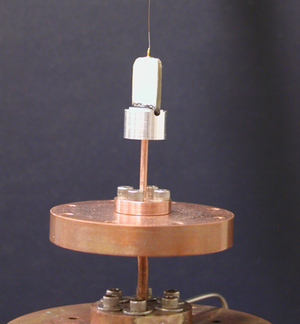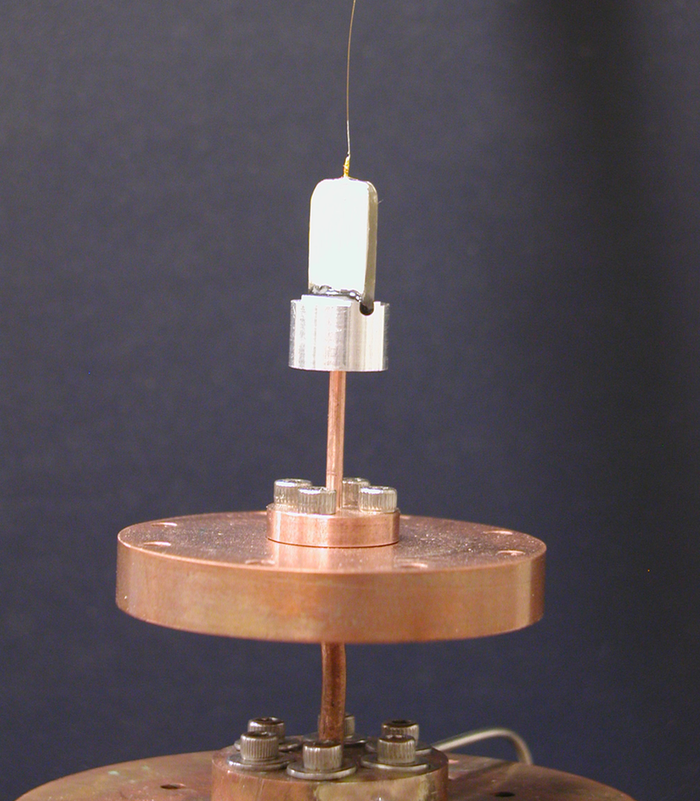Supersolid Discoverer’s New Experiments Show No Supersolid
The concept of “supersolid” helium—a bizarre material that does the atomic-scale equivalent of walking through walls—was supported by experiments in dozens of labs starting in 2004. Many doubts have since emerged, and now the researcher whose work kicked off the field reports in Physical Review Letters that all of those early results were misunderstood. His latest version of the apparatus, designed in response to issues raised since 2004, shows no sign of supersolidity. Researchers in the field say, however, that the pursuit of supersolidity has opened up new areas of study, such as research on the effects of quantum states of atoms on macroscopic material properties.
Theory says that frozen helium might become a “super” substance, where some atoms gang up and pass through the atomic lattice of the normal solid, a completely counterintuitive phenomenon. In 2004, the field of quantum matter got revved up when Eunseong Kim and Moses Chan at Pennsylvania State University in State College reported experiments showing the formation of a supersolid [1]. The team used a torsional oscillator, a hollow disk that hangs down on a rod and oscillates by rotating slightly clockwise and then counterclockwise at a frequency around 1 kilohertz. The oscillation is driven by the rod’s attempt to “untwist” itself after an initial rotational nudge. Kim and Chan packed the disk with Vycor, a spongelike glass containing a labyrinth of nanoscale pores, and filled the Vycor with helium. They then cooled the sample to a fraction of a degree kelvin and applied high pressure to make helium ice.
“Supersolid helium doesn’t like changes in momentum,” explains Chan, “so a fraction of the solid helium stays put and doesn’t contribute to the oscillation.” With less material in motion, the oscillator has a shorter oscillation period if a supersolid is present. Labs around the world reported similar findings (some without the Vycor) but with odd variations in magnitude.
Then in 2007, James Day and John Beamish at the University of Alberta in Canada published a paper that posed a tough challenge to Kim and Chan and others in the field [2]. Suppose that the solid helium was not perfectly stiff but had some “give” (elasticity) that led to a resistance to twisting. If the solid helium were to stiffen up when cooled, the oscillation period would decrease, regardless of the amount of moving mass. “You have to be really careful if all you measure is a period change—supersolidity and elastic effects both have the same temperature dependence,” says Beamish.
This “elastic effect” is a concern for relatively large volumes of helium ice, which can’t form perfect crystals and instead develop crystalline discontinuities called dislocations. The dislocations, where one set of atoms can slide past another, are the source of the temperature-dependent elasticity. Vycor’s pores are too small for dislocations to form, but critics have worried that spaces in the apparatus could be large enough. Worse yet, even tiny amounts of elastic helium can cause huge changes in oscillation and overwhelm any effects from supersolidity [3].
Many other theoretical and experimental results finally convinced Chan to redo the experiments. With postdoctoral researcher Duk Kim, he completely redesigned the torsional oscillator, taking every precaution to eliminate space for elastic helium. This time, the changes in oscillation previously attributed to a supersolid state were completely absent.
Chan realizes that this almost closes the book on supersolid helium. ”I’m in an awkward position, since we started the whole damn thing,” says Chan. “But I’m glad we were the ones who found the explanation.” Beamish agrees that these are extremely subtle effects, which is why it took so long to sort them out: “I give Moses the greatest credit for all the years he spent trying to find out what it was, rather than trying to prove it was what he said it was.” He also notes that the hunt for supersolids actually seeded new research on what has become known as quantum plasticity—the tendency of a material to deform macroscopically based on its quantum properties.
There is still a slight chance supersolidity may be found, however, says Beamish. Experiments by Chan’s former junior colleague Eunseong Kim, now at the Korea Advanced Institute of Science and Technology, and his collaborators, show signs of supersolidity that cannot be explained by elasticity. “Those experiments are currently the most important, and they are just not understood,” says Beamish.
–David Voss
David Voss is an editor for Physics.
References
- E. Kim and M. H. W. Chan, “Probable Observation of a Supersolid Helium Phase,” Nature 427, 225 (2004); E. Kim, “Observation of Superflow in Solid Helium,” Science 305, 1941 (2004)
- James Day and John Beamish, “Low-Temperature Shear Modulus Changes in Solid 4He and Connection to Supersolidity,” Nature 450, 853 (2007)
- H. J. Maris, “Effect of Elasticity on Torsional Oscillator Experiments Probing the Possible Supersolidity of Helium,” Phys. Rev. B 86, 020502 (2012)





